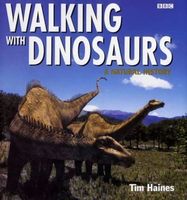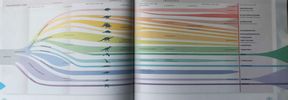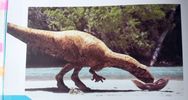 Tytuł: Wędrówki z dinozaurami
Tytuł: Wędrówki z dinozaurami
Tytuł oryginału: Walking with Dinosaurs: A Natural History
Autor(zy): Tim Haines
Tłumaczenie: Brak danych
Rok wydania: 1999 (ENG)
Wydawnictwo: BBC Books (ENG), Muza SA (PL)
Dlaczego w bazie: Książka związana bezpośrednio z telewizyjną serią przyrodniczą o takim samym tytule – chociaż skupia się na dinozaurach, znalazło się też trochę żółwich elementów. Żółwia skorupa widoczna jest na jednym zdjęciu, żółwi zarys jest też pokazany na grafice pokazującej zróżnicowanie gadów. Poza tym, w kilku fragmentach książki pojawiają się wzmianki słowne, przytaczamy je wszystkie poniżej:
Pierwsza wzmianka dotyczy czaszek gadów:
When reptiles first appeared they formed three main groups distinguished by different types of skulls. Today this forms live in turtles, birds and crocodiles, and mammals.
Kolejne dwa fagmenty wspominają o tym, że żółwie morskie muszą wychodzić na ląd by złożyć jaja:
The need to crawl out of the water every year and bury eggs, as turtles do, must have prevented the ichtyosaurs’ ancestors from exploiting the water fully.
But at the same time all four of their limbs were dedicated paddles (turtles have retained stumpy hind limbs for digging holes to lay eggs) and no plesiosaur or pliosaur eggs have ever been discovered.
Kolejny fragment dotyczy tego co widać także na zdjęciu, informuje że dinozaur znalazł martwego żółwia na plaży:
There, in the middle of the beach, is the decaying body of a huge turtle. The Eustreptospondylus bends down and pushes his head into the half-empty shell. With a tug he draws out a large blob of meat and starts to feast.
Porównanie do łap/płetw żółwi morskich:
In the 1970s American paleontologist Jane Robinson studied the muscle attachments of the flippers and concluded that they worked like underwater wings, powering the reptiles through the water just as the flippers of penguins or turtles do today.
Ponowne przypomnienie martwego żółwia:
He heads once again for the cove where he found the roting turtle, and he crosses the headland, the source of the new odour becomes apparent.
Wzmianka, że m.in. żółwie nie mają mieśni twarzy, a więc mimiki:
Crocodiles, lizards and turtles, for example, have no facial muscles; mammals are unique in having such expressive muscular faces, of which cheeks are an integral part.
Wzmianka o żyjących obok dinozaurów dużych, drapieżnych żółwiach:
Being cut off from the marine environment by the cliffs, these lakes have developed unique residents. In particular, they are dominated by large, predatory turtles. Most of the time these unlikely killers litter the beaches, sunning themselves, and seem somewhat slow and cumbersome compared to other aquatic predators. But in the dark waters of the lakes they are highly effective ambush hunters and few fish escape their powerful jaws.
Kolejna wzmianka o żyjących obok dinozaurów żółwiach:
The Ornithocheirus suddenly finds himself sharing his island with numerous big black turtles. He tries wadding away from them, but soon day is not warm enough for him to soar, therefore he takes off and flaps his way slowly to a turtle-free piece of shore.
Ostatnia wzmianka dotyczy tego, że m.in. żółwie przetrwały wydarzenie/proces które doprowadziły do wyginięcia dinozaurów:
However, other mammals, crocodiles, turtles, frogs, salamanders and numerous other marine organisms survived relatively unscathed.




Autor: XYuriTT
